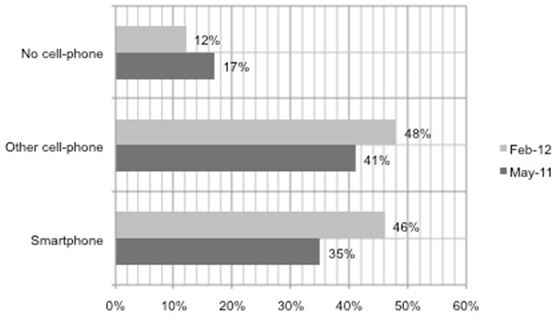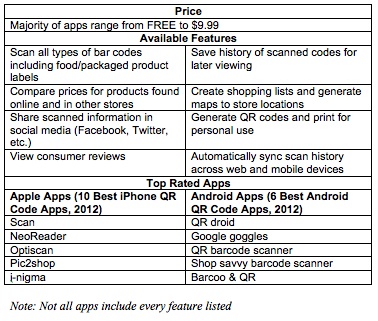 |
April 2013
|
April 2013 // Volume 51 // Number 2 // Tools of the Trade // v51-2tt4
Breaking the Code: The Creative Use of QR Codes to Market Extension Events
Abstract
The use of smartphones has drastically increased in recent years, heralding an explosion in the use of QR codes. The black and white square barcodes that link the physical and digital world are everywhere. These simple codes can provide many opportunities to connect people in the physical world with many of Extension online resources. The challenge is change. Extension faculty must use QR codes so that a savvy public will try something new.
Introduction
The use of smartphones has drastically increased. Nearly half of all Americans now own a smartphone—a cellular phone with built-in software applications and Internet access—a mobile computer. In 2011, only 35% of Americans reported owning a smartphone. Now, 50% of American adults own smartphones (Smith, 2012). This huge increase in smartphone usage has been fueled by upgrades from basic feature cell-phones, or no cell-phone at all (Gustin, 2012).
Figure 1.
Changes in U.S. Smartphone Ownership 2011-12

As a result of the rise in U.S. smartphone adoption, we are now seeing an explosion in the use of QR codes. Business marketers have discovered that these black and white square barcodes are the link between the physical and digital world—now showing up everywhere! In an effort to avoid organizational decline, Extension faculty must adopt this business mindset and embrace the use of QR codes in program promotions (Cox & Franz, 2012).
QR codes are simple to scan, generate, and print on promotional materials. Extension has innumerable opportunities to connect people in the physical world with its research-based information online using creatively marketed QR codes.
What Is a QR Code?
The actual term "QR Code" is a registered trademark of Denso Wave, Inc., a subsidiary of Toyota, which originally developed QR codes in 1994 as a way to identify vehicles in its manufacturing process (About QR Code, 2010). QR is short for "Quick Response."
Figure 2.
Example of a QR Code

QR codes on various marketing materials provide a means for the public to quickly and conveniently access targeted information. Scanning a QR code only requires a mobile app (a software program that runs on smartphones) with the QR scanning feature—just snap a picture of the barcode like you would a normal picture—and within seconds you are redirected to: websites, telephone numbers, messages for texting or email, contact information, or calendar events. To generate a QR codes online just visit qrstuff.com or qrcode.kaywa.com.
QR Scanning and Generating Apps
A wide variety of scanners and generators exist in the Android and Apple markets, each with varying capabilities and pricing. Finding the right QR code scanner and/or generator app is a matter of features and preference.
Figure 3.
Common Features Among QR Scanners and Generators

Ideas for Using QR Codes in Extension
Place a QR code on, in, or near the following locations linking back to Extension factsheets, videos, websites, social media pages, blogs, and more:
- Stalls at livestock shows with feed, nutrition, and husbandry tips.
- Seed, insect, or weed spray products and how to safely use.
- Newspaper articles taking readers to more in-depth instruction on subject matter.
- Baked products at fairs for recipes and nutritional values.
- Turkey and ham products during winter holidays for food preparation, handling instructions, and recipes.
- Gardening implements for how-to's of planting, maintaining individual fruits, vegetables.
- High-traffic area (near food/drinks) at conferences for quick survey evaluation.
- Posters, pamphlets, flyers, handouts, stickers, signs advertising Extension events
- Business cards for access to basic contact information.
- Sewing, quilting fabric, and supplies with information on patterns, materials.
- Canning supplies with preparation directions, handling instructions.
QR Codes are beneficial when the location of the barcode is thoughtful and directed to a relevant source. QR codes must be placed where the public is already looking. Suitable locations to consider include:
- Grocery stores
- Garden centers
- Recreation centers
- Book stores
- Country stores
- Rodeos
- County fairs
- Livestock shows & auctions
- Educational workshops & camps
- Meetings
- Conferences
Always test your barcode to ensure it scans before you print it on anything.
Examples
The greatest challenge lies in persuading faculty and clients to try something new. The potential to access information is not enough to drive clients to start scanning QR codes—there needs to be a reason for them to scan. Below are creative and amusing examples of QR code marketing that reveal how they offer clients real value (Walter, 2012).
- To enhance the user experience, The Cleveland Museum of Art sets QR codes next to exhibits to direct visitors to online or audio tours or to provide more detailed information.
- For brand promotion, Mountain Dew and Taco Bell teamed up to give away music. Customers who scanned QR codes on drink cups were directed to free music downloads.
- To provide customers with real-time updates, the city of Frankfurt, Germany posted advertisements inside trains. By scanning the QR codes on the signs, commuters receive travel information, transport connections, and special offers for frequent passengers.
- To increase sales, Verizon launched a competition where in-store customers scanned a QR code that shared their competition entries on Facebook. If a friend used that link to buy a smartphone, the original customer would win a smartphone.
- To support a cause, Heinz used QR codes to give customers a chance to show their gratitude for American troops. Customers who scanned the code on a ketchup bottle could leave a personalized message to soldiers. For every message sent, Heinz contributed $0.57 to the Wounded Warrior Project.
- To promote agritourism, a French dairy farm painted QR codes on its cows that linked to a widely popular online "scratch game." This creative approach increased visits to the farm, and those who scanned and played had the chance to win discounts and prizes at the farm's gift shop (Plurielle Productions, 2011).
Conclusion
The upsurge in smartphone adoption initiates a terrific opportunity for Extension to connect people in the physical world with its research-based information online through the use of creatively marketed QR codes. To thrive in a climate of ever-changing technology, Extension must successfully navigate immediate challenges and opportunities in marketing its events (Smith & Torppa, 2010). While QR codes are simple to scan, generate, and print on promotional materials, the real challenge lies in motivating Extension faculty to use them and draw clients into trying something new as well.
References
6 best Android QR code apps. (2012). Retrieved from: http://www.techshout.com/features/2012/27/best-android-qr-code-apps/
10 best iPhone QR code apps. (2012). Retrieved from: http://www.techshout.com/features/2012/28/best-iphone-qr-code-apps/
About QR code. (2010). Retrieved from: http://www.denso-wave.com/qrcode/aboutqr-e.html
Cox, R. A., & Franz, N. K. (2012). Extension's future: Time for disruptive innovation. Journal of Extension [On-line], 50(2) Article 2COM1. Available at: http://www.joe.org/joe/2012april/comm1.php
Gustin, S. (2012). Nearly 50% of Americans own smartphones; Android, iPhone dominate. Business.Time.com. Retrieved from: http://business.time.com/2012/03/01/nearly-50-of-americans-own-smartphones-android-iphone-dominate/
Plurielle Productions. (2011). Reportage QRcode...Oh la vache! YouTube.com. Retrieved from: http://youtu.be/3QgFAWFFZqA
Smith, A. (2012). Nearly half of all American adults are smartphone owners. Pew Research Center. Retrieved from: http://pewinternet.org/Reports/2012/Smartphone-Update-2012.aspx
Smith, K. L., & Torppa, C. B. (2010). Creating the capacity for organizational change: Personnel participation and receptivity to change. Journal of Extension [On-line], 48(4) Article 4FEA1. Available at: http://www.joe.org/joe/2010august/a1.php
Walter, E. (2012). 10 Creative ways to use QR codes for marketing. Mashable.com. Retrieved from: http://mashable.com/2012/01/14/qr-code-marketing




